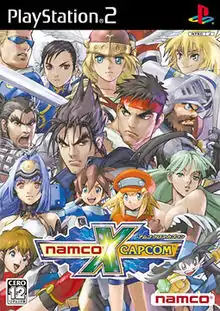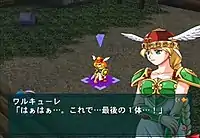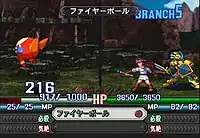Namco × Capcom
Namco × Capcom[lower-alpha 1] (pronounced as "Namco Cross Capcom")[1] is a tactical role-playing (RPG) crossover video game developed by Monolith Soft for the PlayStation 2 and published by Namco in 2005. The gameplay combines tactical RPG and action sequences during battles, featuring characters from video game series owned by Namco and Capcom. The narrative sees original characters Reiji Arisu and Xiaomu, operatives for paranormal investigative group Shinra, confront distortions bringing characters from other realities into their own.
| Namco × Capcom | |
|---|---|
 Cover art | |
| Developer(s) | Monolith Soft |
| Publisher(s) | Namco |
| Director(s) | Soichiro Morizumi |
| Producer(s) | Koji Ishitani |
| Artist(s) | Takuji Kawano Kazue Saito Kazunori Haruyama |
| Writer(s) | Soichiro Morizumi |
| Composer(s) | Yuzo Koshiro |
| Platform(s) | PlayStation 2 |
| Release |
|
| Genre(s) | Tactical role-playing |
| Mode(s) | Single-player |
The project was proposed by Monolith Soft to celebrate Namco's 50th anniversary, and Capcom was contacted as a partner due to their large character roster. Development began in 2003, directed and written by former Banpresto staff member Soichiro Morizumi. The artwork was cooperatively designed by Soulcalibur artist Takuji Kawano, Kazue Saito of Super Robot Wars, and veteran artist Kazunori Haruyama. The soundtrack uses arrangements of themes from the represented series, with original themes composed by Yuzo Koshiro.
First announced in January 2005, the game was never released outside Japan, a fact attributed to the obscurity of some characters and the scale of its script. Releasing to strong sales, the game was given mixed reviews by Japanese and English journalists. Following Namco × Capcom, Monolith Soft would work on some other crossover titles, including the successor Project X Zone in 2012 for the Nintendo 3DS.
Gameplay


Namco × Capcom is a tactical role-playing game which puts players in control of teams of characters drawn from the video game properties of Namco and Capcom.[3] Gameplay is divided into levels, which are unlocked as the player progresses through the narrative. These levels are split between story segments told through character interactions and gameplay where party members face off against enemy parties, with victory conditions which include clearing the field of enemies.[2] In addition to normal story missions, the player can engage in training levels using training dummies to practice moves. They can also purchase items for healing or character boosts at shops using currency won during battles and through a gambling minigame activated between certain story chapters.[4]
Character moves and actions are dictated by Ability Points (AP), of which a set amount is assigned to each character at the beginning of a battle. The game's turn-based battles play out in a grid-based arena from an overhead perspective; each unit on both sides has their turn placed according to their current AP. Any character with ten AP can move and perform actions, with AP being recovered by doing little or nothing for each turn. Movement distance varies between characters, with some walking or flying and others being able to pass over obstacles.[2][3] Playable characters appear in both pairs and as solo units, with different characters specialising in short or long-range attacks based on their abilities in their native series.[5]
When units engage in battle, the game transitions into a horizontal view. Timed button presses trigger different attacks. Each unit's attack number is dictated by a counter labelled "Branch". When the Branch counter is depleted, the battle ends, and if the enemy unit is defeated they disappear from the map. Successful attacks begin a combination, which increase a character's experience point (EXP) reward.[4] Continual attacks also raise a character's fatigue level, which when maxed out will prevent them from moving for several turns.[5]
Successful attacks build up special meters which allow for both a unit-specific special attack and a Multi-Assault attack where another character is called in to deal extra damage.[5] The player party can also engage in a defensive battle when attacked, with successful defending decreasing or nullifying damage and regaining AP. The player can also directly counterattack, which drains AP.[3][4] With each battle, player characters gain experience levels based on earned EXP.[4]
Synopsis
The story opens with Reiji Arisu and his kitsune mentor Xiaomu, operatives for the supernatural investigative task force Shinra, being called to deal with interdimensional rifts opening in their world. These rifts pull in beings from alternate realities, many of which ally with Reiji and Xiaomu to fight both the forces behind the rifts and opponents drawn from their native universes. The group is opposed by Ouma, a group dedicated to causing chaos, with their main rival being Ouma operative Saya, a being similar to Xiaomu. It is eventually revealed that Ouma wishes to resurrect a dark deity dubbed "99" through the merging of multiple realities. Reiji's father Shougo fought Saya to prevent this ten years before and was forced to sacrifice himself with Xiaomu's aid to succeed. While initially defeated, Ouma succeeds in merging the worlds, and 99 is resurrected using Saya as a host. While Reiji is prepared to sacrifice himself as Shougo did, his and Xiaomu's allies return from their realities and combine their powers to cripple 99. Saya allows herself to be killed by Reiji to destroy 99 permanently. At a celebratory party which all their allies attend, Reiji and Xiaomu mutually declare their love for each other.
Characters
| Playable characters[6] | ||
|---|---|---|
Original
|
Namco
|
Capcom
|
Development
Namco × Capcom was developed by Monolith Soft, then a subsidiary of Namco consisting of former Square employees who had gained fame through their work on the Xenosaga series and Baten Kaitos: Eternal Wings and the Lost Ocean. The game was directed and written by Soichiro Morizumi, a former employee of Banpresto and veteran of their Super Robot Wars franchise. The producer was Kouji Ishitani, who had served as an assistant director for Xenosaga Episode I and Baten Kaitos.[7][8] Development began in 2003, and was initially proposed by Monolith Soft as an internal crossover of Namco characters for the company's 50th anniversary.[7] This led to a roster of around 100 characters, but the team wanted a larger roster.[8] To achieve this and create a "more exciting" experience, Namco reached out to Capcom to collaborate on the project. Capcom agreed, breaking the accepted reality of the time for large rival companies not to cooperate on a project.[7][8] The game was Capcom's second major collaboration with another publisher following the SNK vs. Capcom series.[3]
Namco × Capcom was Morizumi's first project for Monolith Soft, and he was in charge of writing the game's scenario.[9] The main theme of the story was "Love", a theme common to Morizumi's later writing.[10] The antagonistic Saya was originally written as "brutal and irritating", but the character's interactions with Xiaomu and the input of her voice actress Ai Orikasa changed Saya into a woman with a big sister persona. This forced multiple rewrites to the script.[11] While he remembered it fondly in later years, Morizumi found the project exhausting.[9] Shinichiro Okamoto, one of the game's executive producers, described the project as difficult for him and credited the rest of the staff with helping the game reach completion.[12]
The character redesigns for Namco and Capcom characters were done by Takuji Kawano, an artist from the Soulcalibur series.[8] The original characters were designed by Kazue Saito, who like Morizumi had worked on the Super Robot Wars franchise. Saito also designed the sprite graphics, and cut-in graphics for battles.[13] The conversation portraits for characters were designed by veteran artist Kazunori Haruyama.[14] The design of main protagonist Reiji was based on the builds of professional wrestlers.[15] The game's opening animation was produced by Production I.G, famous for their work on anime and video game series.[16]
Namco × Capcom was announced in January 2005; at this point, the game was 70% complete.[16] When first announced, Mega Man creator Keiji Inafune praised the initiative behind the project.[8] Namco × Capcom was released in Japan on May 26, 2005.[5] The game was never released internationally. Several outlets cited both its large amount of text, and a lack of worldwide recognition for a lot of represented characters as potential reasons.[1][2][3] A fan translation was created by a group called TransGen, who also created a translation for the PlayStation 2 port of Kingdom Hearts: Chain of Memories. The team working on Namco × Capcom included ten people developing the patch itself, and thirty beta testers. The translation was completed over two years, releasing in 2008.[17][18]
Music
The soundtrack consists mainly of arrangements of themes from represented series. The only credited arranger is Yasunori Mitsuda, who worked on his own tracks for Xenosaga Episode I.[19] The opening theme "Brave New World" and ending theme "Someday, Under the Moon" were composed by Yuzo Koshiro. The game was Koshiro's first time writing vocal themes. Koshiro was brought in to work on Namco × Capcom due to Ishitani being a fan of his work, with the vocal themes being the composer's only contribution to the soundtrack.[20][21] The lyrics were written by Morizumi and both songs were performed by Flair.[19] A special soundtrack album containing selected tracks was released as a first-print bonus with early buyers of the game.[22] A full soundtrack album, which included an extended version of "Brave New World" and karaoke versions of both songs, was released by Capcom's music label Suleputer on August 31, 2005.[23]
Reception
During the weeks following its release, the game came among the top ten best-selling games, reaching sales of nearly 117,000 units by late June.[25] By the end of the year, the game was among the top 100 best-selling games in Japan, with total sales of 131,600.[26]
Japanese magazine Famitsu positively noted the use of kyōgen comedy routines in dialogue, but found other characters lacking development. One reviewer enjoyed the combination-based battles, but another faulted the game's balance.[24] Gaming website Hardcore Gaming 101 said the game was "all about fan service", enjoying the character interactions but finding the gameplay itself very shallow.[27] Siliconera similarly noted shallow and repetitive gameplay, but said that fans of both Namco and Capcom would enjoy the crossover elements.[1]
Hirohiko Niizumi of GameSpot felt that players needed extensive background knowledge of the represented series to enjoy the game, but enjoyed the interactions between characters. He also noted the simplicity of the gameplay, attributed to the need for broad appeal.[3] Anoop Gantayat, writing for IGN, found the visuals lacking despite the game's hardware, and called the story structure "pretty plain". He was also disappointed by the shallow RPG elements.[2]
Legacy
Following the release of Namco × Capcom, the two companies would collaborate on future projects, particularly Street Fighter X Tekken and the Mobile Suit Gundam VS series.[28] The Namco × Capcom development team would later collaborate with Banpresto on the 2008 Nintendo DS game Super Robot Taisen OG Saga: Endless Frontier.[29][30] They released its DS sequel Endless Frontier Exceed, in 2010.[31]
Monolith Soft and Banpresto later co-developed the 2012 Nintendo 3DS title Project X Zone. Designed as a successor to Namco × Capcom with similar gameplay and narrative, Project X Zone combined characters from Sega franchises with returning ones from Namco and Capcom.[32][33][34] Its 2015 sequel, Project X Zone 2, would be developed solely by Monolith Soft and feature additional collaborations with Nintendo franchises.[35][36][37]
References
- "Review: Namco X Capcom". Siliconera. 2005. Archived from the original on 9 June 2007. Retrieved 13 October 2018.
- Gantayat, Anoop (27 May 2005). "Namco X Capcom Playtest". IGN. Archived from the original on 9 July 2013. Retrieved 13 October 2018.
- Niizumi, Hirohiko (27 May 2005). "Namco x Capcom Import Impressions". GameSpot. Archived from the original on 24 August 2005. Retrieved 13 October 2018.
- ナムコ クロス カプコン - ゲームプレイ (in Japanese). Namco × Capcom Website. Archived from the original on 12 March 2010. Retrieved 13 October 2018.
- ナムコ、PS2「ナムコ クロス カプコン(NAMCO×CAPCOM)」メインシステムと最新スクリーンショットを多数公開 (in Japanese). Game Watch Impress. 7 March 2005. Archived from the original on 8 August 2017. Retrieved 13 October 2018.
- ナムコ クロス カプコン - キャラクター (in Japanese). Namco × Capcom Website. Archived from the original on 12 October 2018. Retrieved 13 October 2018.
- Winkler, Chris (25 January 2005). "Namco x Capcom Press Conference Report". RPGFan. Archived from the original on 6 February 2005. Retrieved 28 September 2017.
- "Namco and Capcom announce crossover RPG". GameSpot. 28 January 2005. Archived from the original on 1 December 2013. Retrieved 28 September 2017.
- 「大切なのはコミュニケーション力」『ナムカプ』森住さん (in Japanese). Gpara.com. 25 December 2006. Archived from the original on 14 May 2007. Retrieved 13 October 2018.
- 『無限のフロンティア スーパーロボット大戦OGサーガ』インタビュー全文掲載!. Famitsu. 18 January 2008. Archived from the original on 21 February 2008. Retrieved 10 December 2011.
- Morizumi, Soichiro (7 November 2017). 森住惣一郎 /S.Morizumi - 2:24 AM - 7 Nov 2017 (in Japanese). Twitter. Archived from the original on 10 August 2018. Retrieved 13 October 2018.
- 『ナムコ クロス カプコン』10周年イラストが到着! (in Japanese). Famitsu. 26 May 2015. Archived from the original on 27 December 2015. Retrieved 13 October 2018.
- 「コンセプトを明確に」『ナムカプ』斉藤和衛さん. Gpara.com. 15 January 2007. Archived from the original on 3 December 2013. Retrieved 8 October 2016.
- 「愛の無い批判はしない」『ナムカプ』春山和則さん. Gpara.com. 22 January 2007. Archived from the original on 3 December 2013. Retrieved 8 October 2016.
- Morizumi, Soichiro (14 January 2018). 森住惣一郎 /S.Morizumi - 8:24 AM - 14 Jan 2018 (in Japanese). Twitter. Archived from the original on 10 August 2018. Retrieved 13 October 2018.
- Winkler, Chris (26 January 2005). "Monolith Soft Announces Namco Vs. Capcom". RPGFan. Archived from the original on 11 February 2005. Retrieved 13 October 2018.
- Len, God (5 May 2008). "Namco X Capcom translation patch released now!". Japanator. Archived from the original on 12 October 2018. Retrieved 13 October 2018.
- "COLUMN: Quiz Me Qwik - 'Talking 'Bout Saito's Translation Generation'". VideoGamesDaily.com. 2008. Archived from the original on 15 October 2017. Retrieved 13 October 2018.
- Monolith Soft. "Namco × Capcom Original Soundtrack liner notes." (in Japanese) Suleputer. 31 August 2005. CPCA-10118. Retrieved on 13 October 2018.
- "Interview with Yuzo Koshiro". Square Enix Music Online. 2011. Archived from the original on 17 February 2018. Retrieved 13 October 2018.
- Kikizo (14 October 2005). "Yuzo Koshiro Interview". VideoGamesDaily.com. Archived from the original on 5 February 2012. Retrieved 6 August 2011.
- 「ナムコ クロス カプコン」購入者特典はナムコ、カプコンの名BGMが集められた「スペシャルサントラCD」 (in Japanese). Game Watch Impress. 30 March 2005. Archived from the original on 30 June 2013. Retrieved 13 October 2018.
- ナムコ クロス カプコン オリジナル・サウンドトラック (in Japanese). Suleputer. Archived from the original on 2 March 2007. Retrieved 13 October 2018.
- (PS2) ナムコ クロス カプコン (in Japanese). Famitsu. Archived from the original on 13 October 2018. Retrieved 13 October 2018.
- ゲームソフト販売本数ランキング TOP30 (in Japanese). Famitsu. 23 June 2005. Archived from the original on 30 June 2005. Retrieved 13 October 2018.
- "GEIMIN.NET/2005年テレビゲームソフト売り上げTOP500" (in Japanese). Geimin.net. Archived from the original on 28 December 2014. Retrieved 5 January 2014.
- "Namco X Capcom - Playstation 2 (2005)". Hardcoregaming 101. 2006. Archived from the original on 24 February 2007. Retrieved 13 October 2018.
- カプコンとバンダイナムコ、再びクロス!「ストリートファイター」×「鉄拳」のコラボレーション2作が発表 (in Japanese). Game Watch Impress. 26 July 2010. Archived from the original on 6 August 2017. Retrieved 13 October 2018.
- フロンティア、集う! (in Japanese). Bandai Namco Entertainment. 14 March 2008. Archived from the original on 27 February 2016. Retrieved 24 September 2017.
- バンプレストとモノリスソフトが生み出す新たなRPG!『無限のフロンティア スーパーロボット大戦OGサーガ』【映像インタビューつき】 (in Japanese). Famitsu. 11 January 2008. Archived from the original on 13 January 2008. Retrieved 28 September 2017.
- 戦闘シーンの動画つきロングインタビュー『無限のフロンティアEXCEED スーパーロボット大戦OGサーガ』 (in Japanese). Famitsu. 9 October 2009. Archived from the original on 10 October 2009. Retrieved 28 September 2017.
- "Ein Interview und viele Screenhots zu Project X Zone" (in German). JPGames.de. 13 April 2012. Archived from the original on 6 April 2017. Retrieved 24 September 2017.
- Schreier, Jason (21 January 2013). "That Crazy Sega/Namco/Capcom Crossover RPG Project X Zone Is Coming To America". Kotaku. Archived from the original on 23 January 2013. Retrieved 28 September 2017.
- 社長が訊く『ニンテンドー3DS』ソフトメーカークリエーター 篇 - 第21回:『PROJECT X ZONE』 (in Japanese). Nintendo. 2012. Archived from the original on 12 December 2016. Retrieved 28 September 2017.
- 『PROJECT X ZONE 2:BRAVE NEW WORLD(プロジェクト クロスゾーン2:ブレイブニューワールド)』開発者インタビュー (in Japanese). Famitsu. 20 April 2014. Archived from the original on 28 September 2017. Retrieved 28 September 2017.
- Whitehead, Thomas (12 February 2016). "Interview: Learning More About The 'Ultimate Crossover' RPG, Project X Zone 2, From Its Creators". Nintendo Life. Archived from the original on 13 February 2016. Retrieved 28 September 2017.
- Romano, Sal (9 September 2015). "Project X Zone 2 adds Fire Emblem, Xenosaga, and Xenoblade characters". Gematsu. Archived from the original on 8 December 2015. Retrieved 19 September 2015.